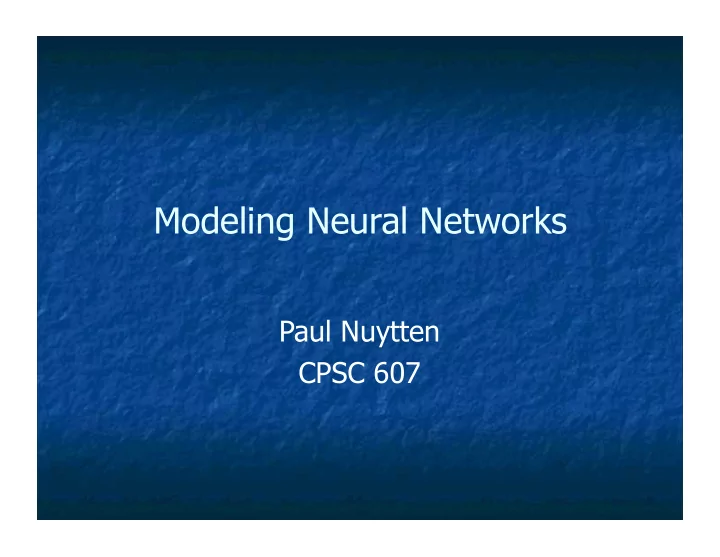

Modeling Neural Networks Paul Nuytten CPSC 607
Outline Why model neural networks? A brief look at the neuron. A look at some current works. Adding an evolutionary strategy.
Why Model Neural Networks? The nervous system is a very complex system with many hidden properties. Many experiments cannot be performed in vivo without destroying the specimen; leaving many questions unanswered. When looking at a model many of the redundant structures and processes can be removed leaving a more focused picture. The nervous system is a very efficient and massively parallel computational device. Models may capture this property to solve a certain class of problems.
The Neuron
The Neuron The neuron shares many of the same components as many other types of cells. It’s the unique structures that make the neuron a powerful communication and computational device.
The Neuron The unique components are The dendrites The axon The synapses
The Dendrites The dendrites are short strands that protrude from the cell body or the soma. The dendrites are very receptive to connections from other neurons. The dendrites carry signals from the synapses to the soma.
The Axon The axon is a long extension from the soma. Each neuron only has one axon. The axon is myelinated if it is insulated with Schwann cells.
The Axon If the axon is myelinated the action potential will travel much faster. The axon carries action potentials from the soma to the synapses.
The Synapse The synapses are the connections made by an axon to another neuron. When an action potential arrives at a synapse from the postsynaptic cell, neurotransmitter is released into the synaptic cleft.
The Synapse The neurotransmitter will interact with ion channels on the membrane of the postsynaptic cell causing them to open letting some ions into the cell while letting other ions escape. A synapse is call excitatory if it raises the local membrane potential of the post synaptic cell. Inhibitory if the potential is lowered.
What level should be modeled?
Some Current Works NEURON GENISIS Neural Swarm Evolutionary Artificial Neural Networks
NEURON NEURON is a simulation environment for neurons and neural networks. The NEURON simulation allows a user to focus on the biological and biophysical aspects of a neurological system. Great tool for biologists.
NEURON
GENISIS GEneral NEural SImulation System Provides a simulation environment for biologically realistic models. Very similar to NEURON. Allows for parallel processing.
Neural Swarm Uses the concepts of swarm intelligence when creating neurological models. Still in its infancy. Instead of designing the network and defining processes in mathematical terms, the network and processes are allowed to emerge from the simple interactions within the system. The results are then compared to biologically observed results.
Neural Swarm
Evolutionary Artificial Neural Networks Focuses more on the computational aspect of artificial neural networks (using them to solve problems). Uses outgrowth and pruning rules to grow a neural network. Spontaneous neural activity also contributes to the development of the network. What is nice about this simulation is its ability to apply a genetic algorithm to the above rules and the network’s morphology to specialize the network to a given problem.
Evolutionary Artificial Neural Networks
Evolutionary Artificial Neural Networks
Conclusion When creating a simulation it is important to identify the level at which to model. It is also important to identify the target audience and intended use of your simulation. Start simple and gradually add complexity. Collaborate.
References F. Bloom, C. Nelson, A. Lazerson. Brain, Mind and Behavior Third Edition. Worth Publishers, USA, 2001. N. Campbell. Biology Fourth Edition, pages 993-1009. The Benjamins/Cummings Publishing Company, Inc., Menlo Park, California, 1996. R. Rojas. Neural Networks A Systematic Introduction. Springer- Verlag, Berlin, 1996. Rust A.G., Adams R., Schilstra M. and Bolouri H. Evolving computational neural systems using synthetic developmental mechanisms. 2003. http://www.rwc.uc.edu/koehler/biophys/4d.html http://www.neuron.yale.edu/neuron/ http://www.genesis-sim.org/GENESIS/ http://strc.herts.ac.uk/bio/alistairr/neural_interests.html
Recommend
More recommend